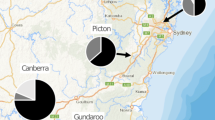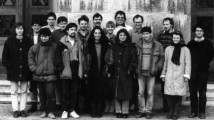Abstract
Reproductive skew theory has been an important component of efforts to design a unifying theory of social evolution, as it aims to explain patterns of reproductive partitioning in animal societies as a function of relatedness, group productivity, fighting ability and ecological constraints on independent reproduction. However, empirical tests of the theory have often provided ambiguous or non-conclusive results, assumptions behind alternative models have rarely been tested, and theoretical elaborations have shown the limitations of the reproductive skew approach. Here we analyse a relatively large sample of colonies of the Stenogastrine wasp Parischnogaster mellyi with a powerful set of DNA microsatellite markers. We show that various apparently stable forms of social organisation co-exist in a single population, and that sharing of reproduction between related and unrelated egg-laying females occurs in some of the nests. Present reproductive skew theory appears to be at best partly sufficient to account for the observed complexity of social organisation. The observed patterns of colony composition and reproductive sharing are weakly consistent with the hypothesis of reproductive transactions, while they can more parsimoniously be explained by the life-history characteristics of the species.




Similar content being viewed by others
References
Boomsma JJ, Grafen A (1990) Intraspecific variation in ant sex ratios and the Trivers-Hare hypothesis. Evolution 44:1026–1034
Boomsma JJ, Grafen AA (1991) Colony-level sex ratio selection in the eusocial Hymenoptera. J Evol Biol 4:383–407
Bourke AT (2001) Reproductive skew and split sex ratios in social Hymenoptera. Evolution 55:2131–2136
Cant MA, Field J (2001) Helping effort and future fitness in cooperative animal societies. P Roy Soc Lond B Bio 268:1959–1964
Field J, Solis CR, Queller DC, Strassmann JE (1998) Social and genetic structure of paper wasp cofoundress associations: tests of reproductive skew models. Am Nat 151:545–563
Field J, Shreeves G, Sumner S (1999) Group size, queuing and helping decisions in facultatively eusocial hover wasps. Behav Ecol Sociobiol 45:378–385
Goodnight KF, Queller DC (1997) Kinship 1.5b4. Goodnight Software, Houston
Goodnight KF, Queller DC (2000) Relatedness 5.0.8. Goodnight Software, Houston
Hansell MH (1983) Social behaviour and colony size in the wasp Parischnogaster mellyi (Sassure), Stenogastrinae (Hymenoptera, Vespidae). Proc K Ned Akad Wet Ser C 86:167–178
Helms Cahan S, Blumstein DT, Sundström L, Liebig J, Griffin A (2002) Social trajectories and the evolution of social behaviour. Oikos 96:206–216
Johnstone RA (2000) Models of reproductive skew: a review and synthesis. Ethology 106:5–26
Johnstone RA, Cant MA (1999) Reproductive skew and the threat of eviction: a new perspective. P Roy Soc Lond B Bio 266:275–279
Johnstone RA, Woodroffe R, Cant MA, Wright J (1999) Reproductive skew in multimember groups. Am Nat 153:315–331
Keller L, Krieger MJB (1996) Mating success of birds. Nature Lond 380:208–209
Kokko A (2003) Are reproductive skew models evolutionarily stable? P Roy Soc Lond B Bio 270:265–270
Kokko H, Johnstone RA (1999) Social queuing in animal societies: a dynamic model of reproductive skew. P Roy Soc Lond B Bio 266:571–578
Landi M, Queller DC, Turillazzi S, Strassmann JE (2003) Low relatedness and frequent queen turnover in the stenogastrine wasp Eustenogaster fraterna favor the life insurance over the haplodiploid hypothesis for the origin of eusociality. Insect Soc 50:262–267
Magrath RD, Heinsohn RG (2000) Reproductive skew in birds: models, problems and prospects. J Avian Biol 31:247
Mehdiabadi NJ, Reeve HK, Mueller UG (2003) Queens versus workers: sex-ratio conflict in eusocial Hymenoptera. Trends Ecol Evol 18:88–93
Nonacs P (2000) Measuring and using skew in the study of social behaviour and evolution. Am Nat 156:577–589
Nonacs P (2003) Measuring the reliability of skew indices: is there one best index? Anim Behav 65:615–627
Pamilo P, Crozier RH (1996) Reproductive skew simplified. Oikos 75:533–535
Queller DC, Zacchi F, Cervo R, Turillazzi S, Henshaw MT, Santorelli LA, Strassmann JE (2000) Unrelated helpers in a social insect. Nature 405:784–787
Ragsdale JE (1999) Reproductive skew theory extended: the effect of resource inheritance on social organization. Evol Ecol Res 1:859–874
Reeve HK (1998) Game theory, reproductive skew, and nepotism. In: Dugatkin L, Reeve HK (eds) Game theory and animal behaviour. Oxford University Press, Oxford pp 118–145
Reeve HK (2000) A transactional theory of within-group conflict. Am Nat 155:365–382
Reeve HK, Keller L (2001) Tests of reproductive-skew models in social insects. Annu Rev Entomol 46:347–385
Reeve HK, Nonacs P (1997) Within-group aggression and the value of group members: theory and a field test with social wasps. Behav Ecol 8:75–82
Reeve HK, Ratnieks FLW (1993) Queen-queen conflicts in polygynous societies: mutual tolerance and reproductive skew. In: Keller L (ed) Queen number and sociality in Insects. Oxford University Press, Oxford, pp 45–85
Reeve HK, Emlen ST, Keller L (1998) Reproductive sharing in animal societies: reproductive incentives or incomplete control by dominant breeders? Behav Ecol 9:267–278
Reeve HK, Starks PT, Peters JM, Nonacs P (2000) Genetic support for the evolutionary theory of reproductive transactions in social wasps. P Roy Soc Lond B Bio 267:75–79
Reeve JK, Emlen ST (2000) Reproductive skew and group size: an N-person staying incentive model. Behav Ecol 11:640–647
Seppä P, Queller DC, Strassmann JE (2002) Reproduction in foundress associations of the social wasp, Polistes carolina: conventions, competition, and skew. Behav Ecol 13:531–542
Sumner S, Field J (2001) Highly polymorphic microsatellite loci in the facultatively eusocial hover wasp, Liostenogaster flavolineata and cross-species amplification. Mol Ecol Notes 1:229–231
Sumner S, Casiraghi M, Foster W, Field J (2002) High reproductive skew in tropical hover wasps. P Roy Soc Lond B Bio 269:179–186
Tòth E, Strassmann JE, Nogueira-Neto P, Imperatriz-Fonseca VL, Queller DC (2002) Male production in stingless bees: variable outcomes of queen-worker conflict. Mol Ecol 11:2661–2667
Turillazzi S (1991) The Stenogastrinae. In: Ross KG, Matthews RW (eds) The social biology of wasps. Cornell University Press, Ithaca, NY, pp 74–98
Turillazzi S (1996) Polistes in perspective: comparative social biology in Belonogaster and Stenogastrinae. In: Turillazzi S, West-Eberhard MJ (eds) Natural history and evolution of paper-wasps. Oxford Science, Oxford, pp 235–248
West-Eberhard MJ (1981) Intragroup selection and the evolution of insect societies. In: Alexander RD, Twinkle DW (eds) Natural selection and social behaviour. Chiron, New York, pp 3–17
Wilson EO (1971) The insect societies. Harvard University Press, Cambridge, MA
Yamane S, Sakagami SF, Ohgushi R (1983) Multiple behavioural options in a primitively social wasp, Parischnogaster mellyi. Insect Soc 30:412–415
Zhu Y, Landi M, Queller DC, Turillazzi S, Strassmann JE (2000) Polymorphic microsatellite loci for primitively eusocial Stenogastrinae wasps. Mol Ecol 9:2203–2205
Acknowledgements
We thank Professor Rosli Hashim (University of Malaya, Kuala Lumpur, Malaysia) for logistic support during the field work, Sylvia Mathiasen for helping with the genetic analyses, and an anonymous referee for suggestions that helped to improve the manuscript. The experiments reported comply with the current laws of the countries in which they were performed. Funding of this work was obtained through the research network INSECTS of the universities of Copenhagen, Florence, Keele, Lausanne, Oulu, Regensburg, Sheffield and ETH Zürich, financed by the European Commission via the Research Training Network established under the Improving Human Potential Programme (HPRN-CT-2000-00052); through the Italian MIUR (COFIN 2001 project “Comunicazione animale: studio integrato sulla comunicazione chimica negli Insetti Sociali”) and the University of Florence.
Author information
Authors and Affiliations
Corresponding author
Additional information
Communicated by R.F.A. Moritz
Rights and permissions
About this article
Cite this article
Fanelli, D., Boomsma, J.J. & Turillazzi, S. Multiple reproductive strategies in a tropical hover wasp. Behav Ecol Sociobiol 58, 190–199 (2005). https://doi.org/10.1007/s00265-005-0908-8
Received:
Revised:
Accepted:
Published:
Issue Date:
DOI: https://doi.org/10.1007/s00265-005-0908-8




